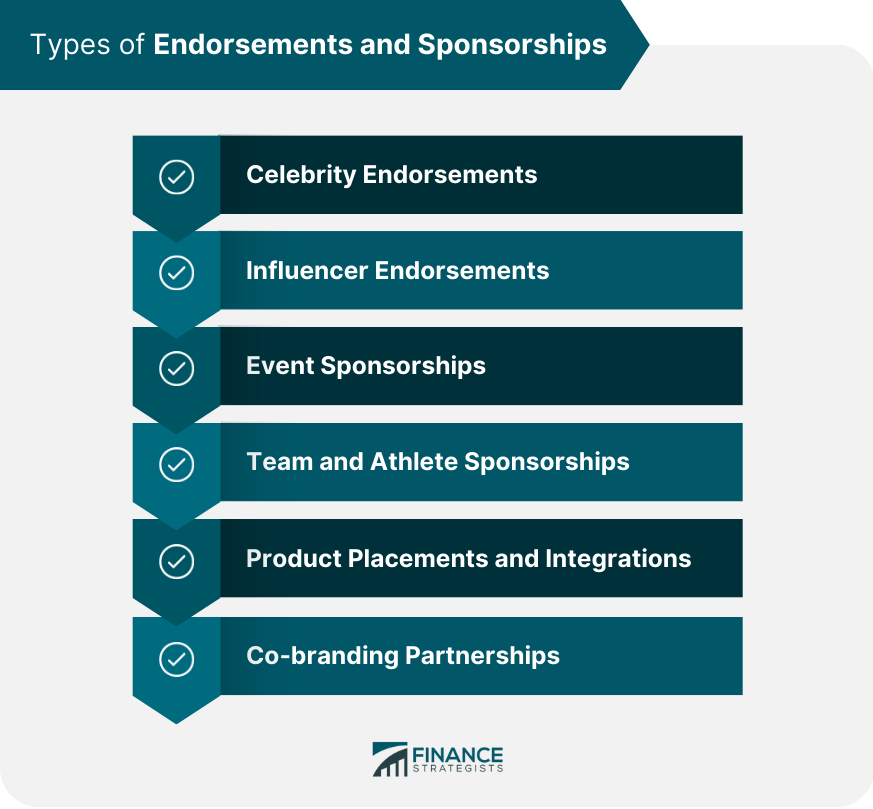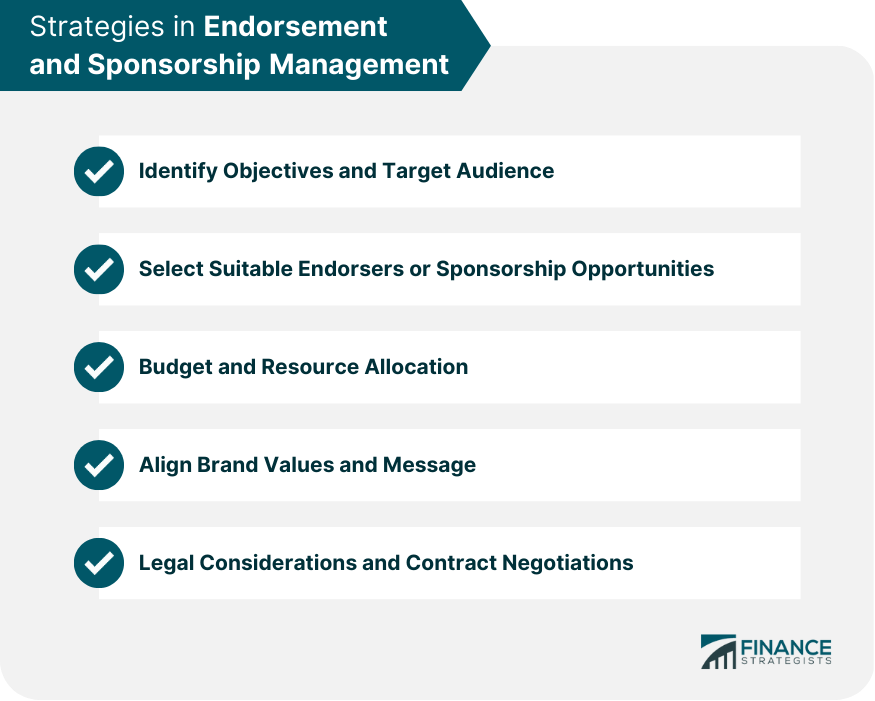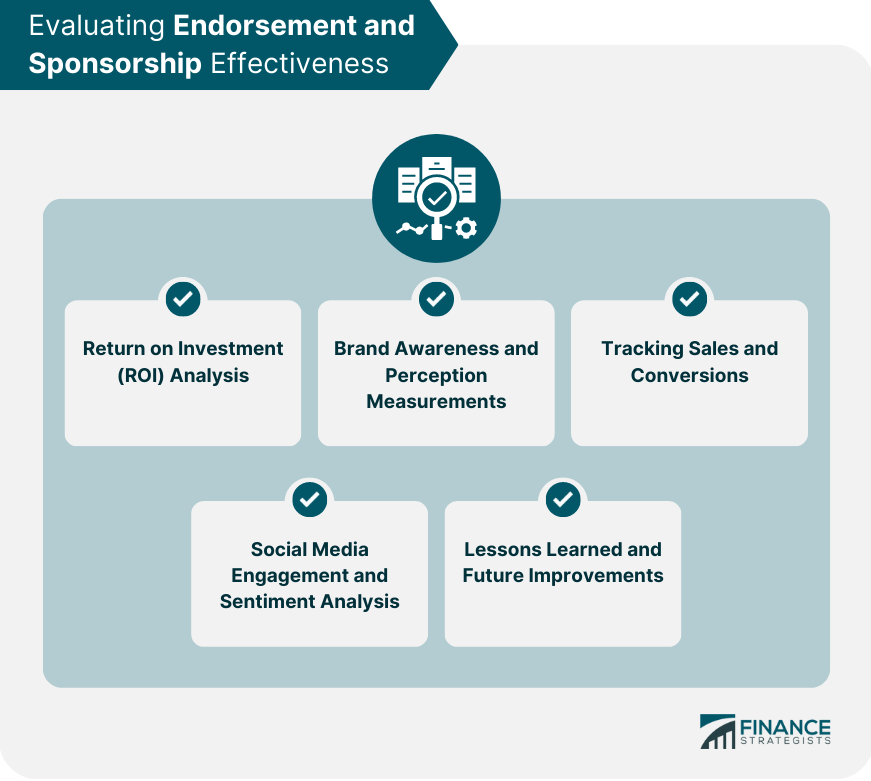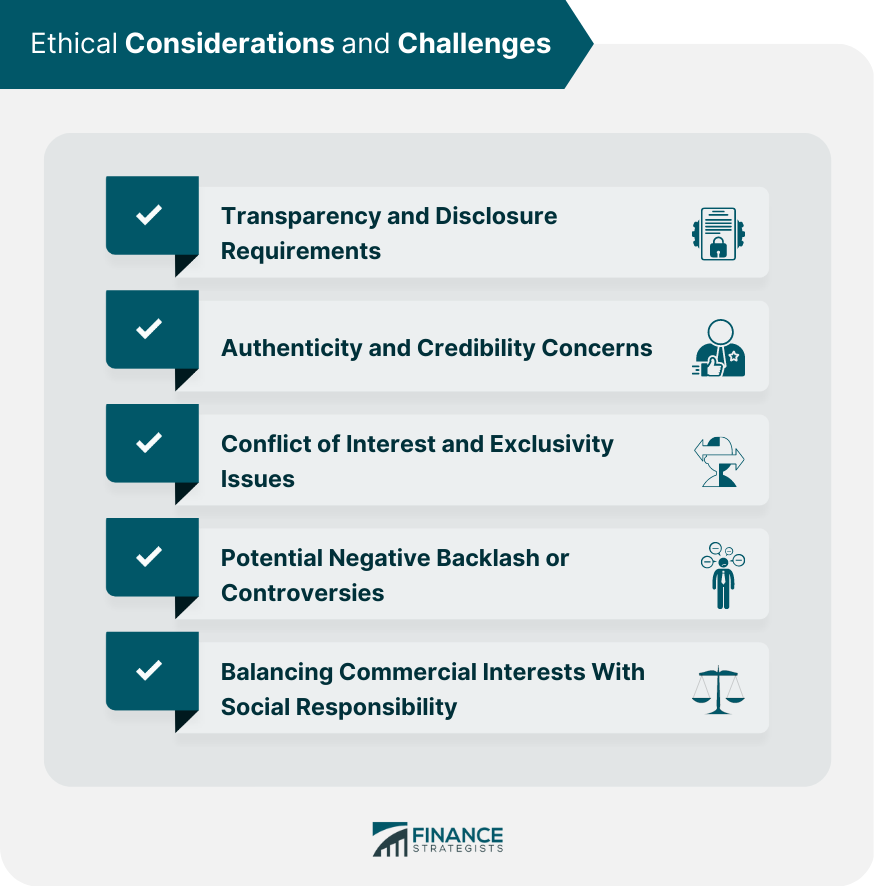Endorsement and sponsorship management refers to the process of managing relationships between individuals or organizations and brands or products. Endorsement involves a public figure, such as a celebrity or an athlete, using their reputation and influence to promote a brand or product. This can involve anything from appearing in advertisements to making public appearances or speaking engagements on behalf of the brand. Sponsorship involves a brand or product providing financial support or other resources to an individual or organization in exchange for exposure or promotion. For example, a sports team might receive sponsorship from a company in exchange for featuring the company's logo on their jerseys or promoting the company's products to their fans. Celebrities can be powerful endorsers due to their massive fan following and influence. Brands often collaborate with celebrities to promote their products or services, leveraging the celebrity's fame to reach a broader audience. Influencers are individuals with a strong presence on social media and a dedicated follower base. They have gained trust and credibility among their audience, making them ideal for product endorsements or sponsored content. Brands can associate themselves with events such as concerts, sports tournaments, or charity fundraisers. These sponsorships provide exposure to a specific target audience, showcase brand values, and create a positive association with the event. Sponsoring sports teams or individual athletes can help brands increase visibility, tap into fan loyalty, and align with the positive image of the athlete or team. Brands can subtly integrate their products or services into television shows, movies, or other media content to reach consumers in a more immersive way. Collaborations between two or more brands can create a synergistic effect, offering consumers unique products or experiences that reflect the strengths and values of each partner. To develop an effective endorsement or sponsorship strategy, brands must first define their objectives and identify their target audience. This helps to ensure that the chosen endorsers or sponsorship opportunities align with the brand's goals and desired market segment. Careful selection of endorsers or sponsorship opportunities is essential to maximize the impact of the campaign. Factors to consider include the endorser's relevance to the target audience, their credibility and influence, and the potential for a long-term partnership. Determining the budget and allocating resources for endorsement and sponsorship activities is a crucial step in the planning process. Brands must consider the costs associated with talent fees, event sponsorships, marketing materials, and promotional efforts. The endorser or sponsorship opportunity must align with the brand's values and messaging. This ensures consistency in communication and helps to establish a strong brand identity. Brands must address legal considerations, such as intellectual property rights, exclusivity clauses, and disclosure requirements, during contract negotiations with endorsers or sponsorship partners. Effective coordination of endorsement or sponsorship activities is crucial to ensure that all parties involved meet their obligations and that the campaign runs smoothly. Brands must closely monitor timelines and deliverables to ensure that endorsement or sponsorship activities align with their overall marketing strategy and goals. Maintaining brand consistency and compliance across all endorsement or sponsorship activities is vital to build trust and credibility among consumers. Endorsement and sponsorship activities should be seamlessly integrated with other marketing channels, such as social media, advertising, and public relations, to create a cohesive brand experience. Monitoring the performance of endorsement or sponsorship activities allows brands to make data-driven decisions and adjust their plans as needed to optimize results. To assess the success of endorsement or sponsorship activities, brands should analyze the return on investment (ROI). This involves comparing the costs of the campaign to the financial benefits gained, such as increased sales or market share. Measuring brand awareness and perception can help brands understand the impact of their endorsement or sponsorship activities on consumer attitudes and recall. Monitoring sales and conversions resulting from endorsement or sponsorship activities provides valuable insights into the campaign's effectiveness and helps identify areas for improvement. Analyzing social media engagement and sentiment can offer valuable insights into consumer reactions to endorsement or sponsorship activities and help brands identify trends and potential issues. Evaluating the effectiveness of endorsement and sponsorship activities enables brands to learn from their experiences, refine their strategies, and make informed decisions for future campaigns. Brands must adhere to transparency and disclosure requirements, such as the Federal Trade Commission's guidelines in the United States, to ensure that consumers are aware of any sponsored content or endorsements. Maintaining authenticity and credibility is vital for brands engaging in endorsement or sponsorship activities. Consumers are increasingly skeptical of overly commercial messages and are more likely to trust genuine recommendations from endorsers they admire. Brands must carefully navigate potential conflicts of interest and exclusivity issues when engaging in endorsement or sponsorship activities to protect their reputation and maintain positive relationships with endorsers and partners. Endorsement and sponsorship activities can sometimes lead to negative backlash or controversies if they are perceived as inauthentic or exploitative. Brands must be prepared to address any issues that may arise and take corrective action if needed. Brands should balance their commercial interests with social responsibility, ensuring that their endorsement and sponsorship activities contribute positively to society and align with their values and ethics. Endorsement and Sponsorship Management involves managing relationships between individuals or organizations and brands or products, with endorsement involving a public figure using their reputation and influence to promote a brand or product. Such sponsorship involves a brand providing support or resources to an individual or organization in exchange for exposure or promotion. Different types of endorsements and sponsorships include celebrity endorsements, influencer endorsements, event sponsorships, team and athlete sponsorships, product placements and integrations, and co-branding partnerships. Strategies involve identifying objectives and target audience, selecting suitable endorsers or sponsorship opportunities, budgeting and resource allocation, aligning brand values and message, and legal considerations and contract negotiations. Implementation and execution involve coordinating endorsement or sponsorship activities, monitoring timelines and deliverables, ensuring brand consistency and compliance, integrating with other marketing channels, and measuring performance. Ethical considerations and challenges involve transparency and disclosure requirements, authenticity and credibility concerns, conflict of interest and exclusivity issues, potential negative backlash, and balancing commercial interests with social responsibility.What Is Endorsement and Sponsorship Management?
Types of Endorsements and Sponsorships
Celebrity Endorsements
Influencer Endorsements
Event Sponsorships
Team and Athlete Sponsorships
Product Placements and Integrations
Co-branding Partnerships

Strategies in Endorsement and Sponsorship Management
Identifying Objectives and Target Audience
Selecting Suitable Endorsers or Sponsorship Opportunities
Budgeting and Resource Allocation
Aligning Brand Values and Message
Legal Considerations and Contract Negotiations

Implementation and Execution
Coordinating Endorsement or Sponsorship Activities
Monitoring Timelines and Deliverables
Ensuring Brand Consistency and Compliance
Integration With Other Marketing Channels
Measuring Performance and Adjusting Plans as Needed
Evaluating Endorsement and Sponsorship Effectiveness
Return on Investment (ROI) Analysis
Brand Awareness and Perception Measurements
Tracking Sales and Conversions
Social Media Engagement and Sentiment Analysis
Lessons Learned and Future Improvements

Ethical Considerations and Challenges
Transparency and Disclosure Requirements
Authenticity and Credibility Concerns
Conflict of Interest and Exclusivity Issues
Potential Negative Backlash or Controversies
Balancing Commercial Interests With Social Responsibility

Conclusion
Endorsement & Sponsorship Management FAQs
When selecting endorsers or sponsorship opportunities, brands should consider factors such as the endorser's relevance to the target audience, their credibility and influence, alignment with the brand's values and messaging, and the potential for a long-term partnership.
Brands can evaluate the effectiveness of their endorsement and sponsorship activities by analyzing the return on investment (ROI), measuring brand awareness and perception, tracking sales and conversions, monitoring social media engagement and sentiment, and applying lessons learned to improve future campaigns.
Brands should be mindful of ethical considerations and challenges such as transparency and disclosure requirements, maintaining authenticity and credibility, navigating conflict of interest and exclusivity issues, addressing potential negative backlash or controversies, and balancing commercial interests with social responsibility.
Emerging trends in endorsement and sponsorship management include the rise of micro-influencers and niche markets, virtual influencers and digital endorsements, sponsorship activation through technology and innovation, and the increasing importance of data analytics in decision-making.
Brands can ensure that their endorsement and sponsorship activities contribute positively to society and align with their values and ethics by carefully selecting endorsers and sponsorship opportunities that reflect their brand values, maintaining transparency and disclosure, fostering authentic and credible relationships with endorsers and partners, and balancing commercial interests with social responsibility.
True Tamplin is a published author, public speaker, CEO of UpDigital, and founder of Finance Strategists.
True is a Certified Educator in Personal Finance (CEPF®), author of The Handy Financial Ratios Guide, a member of the Society for Advancing Business Editing and Writing, contributes to his financial education site, Finance Strategists, and has spoken to various financial communities such as the CFA Institute, as well as university students like his Alma mater, Biola University, where he received a bachelor of science in business and data analytics.
To learn more about True, visit his personal website or view his author profiles on Amazon, Nasdaq and Forbes.















